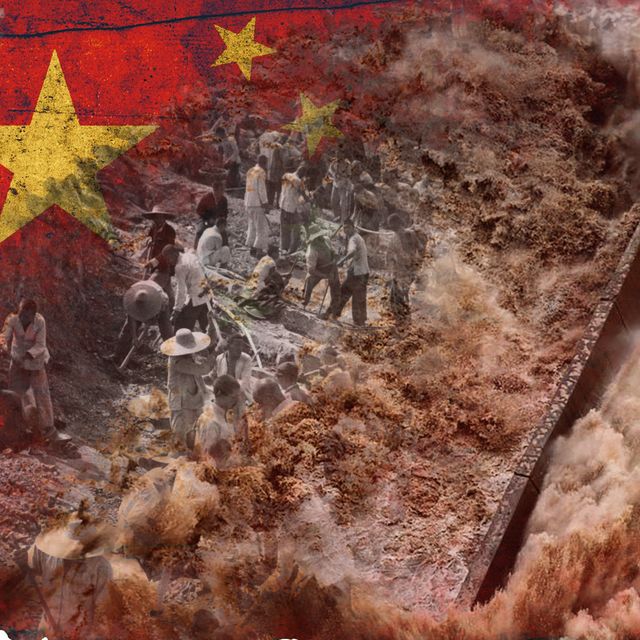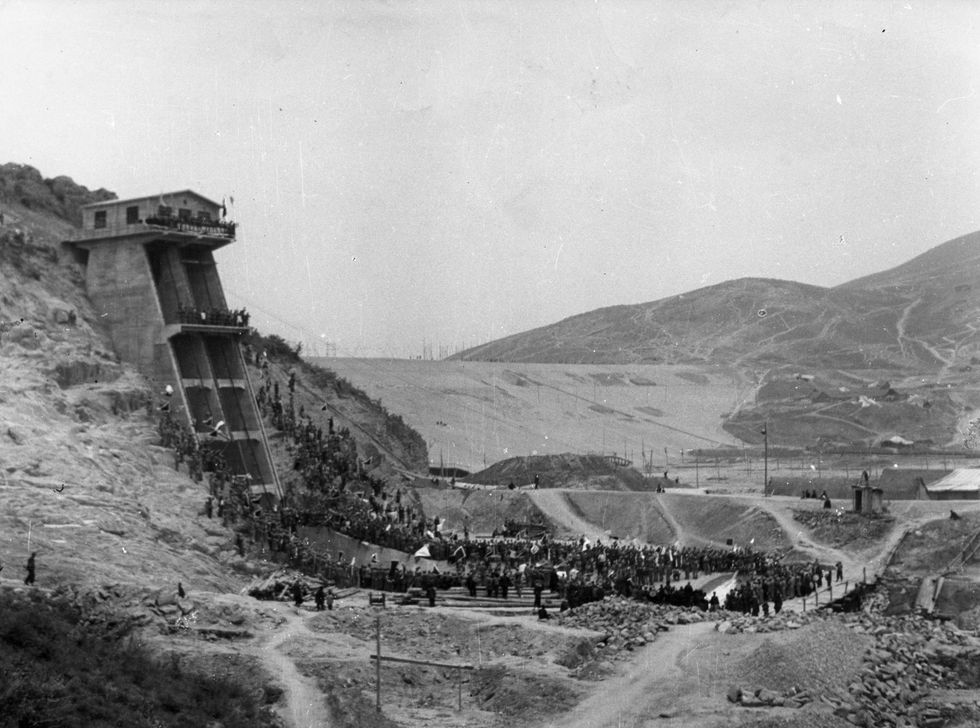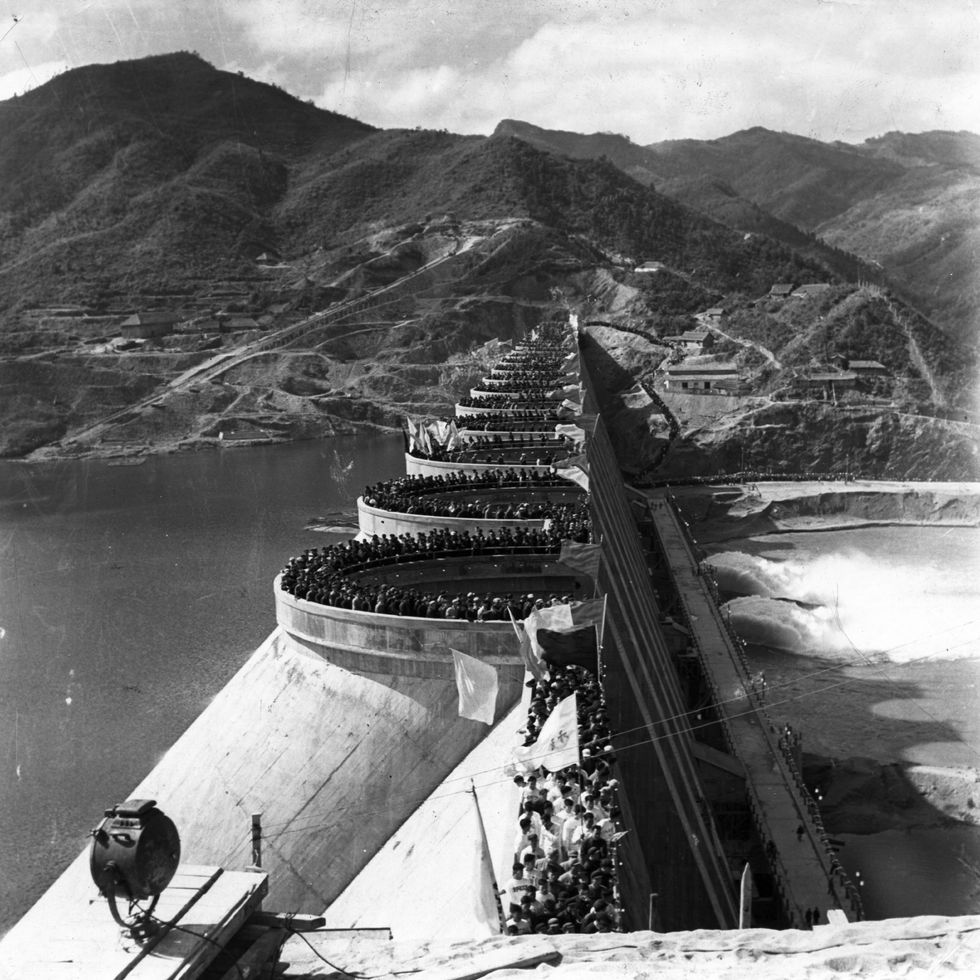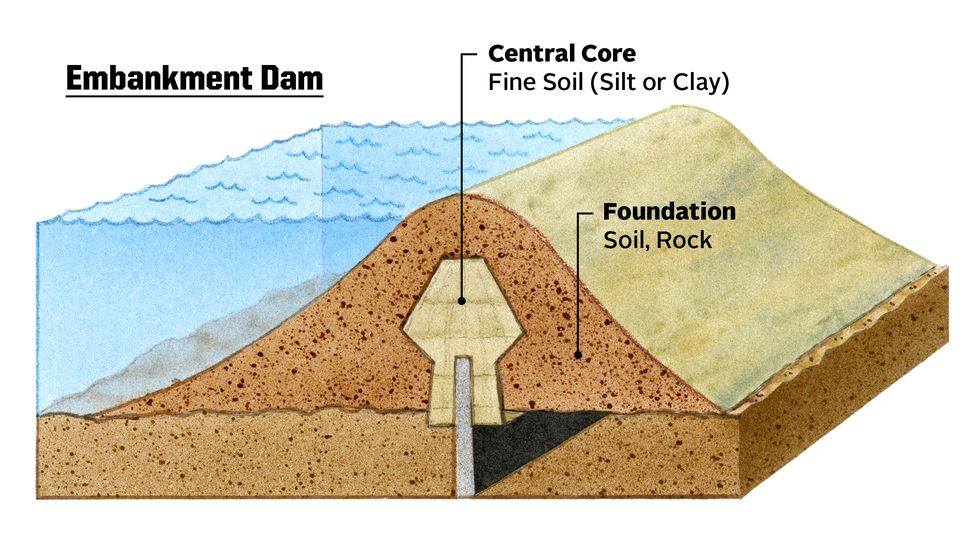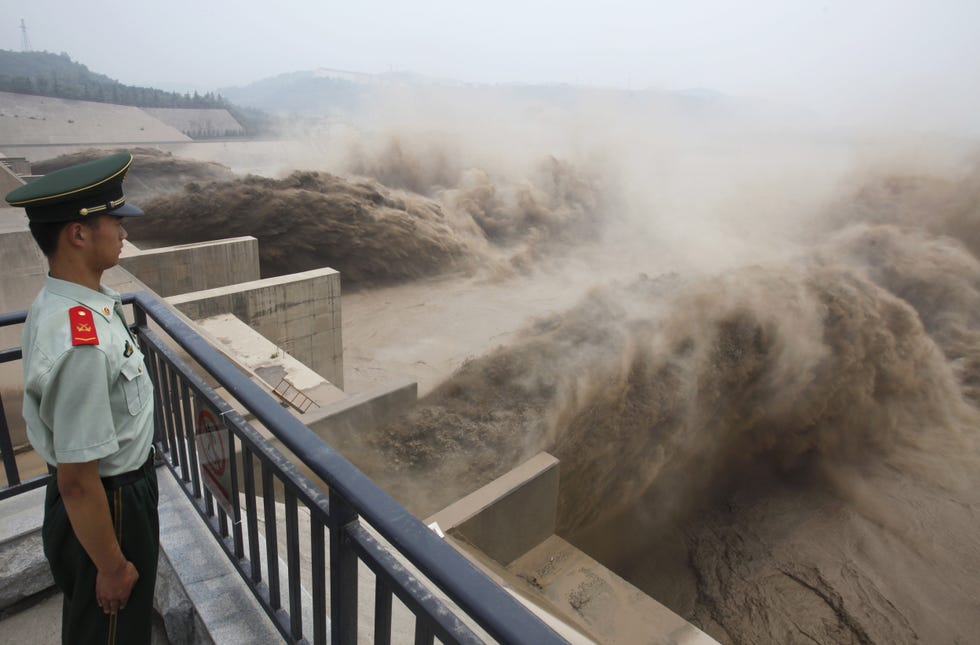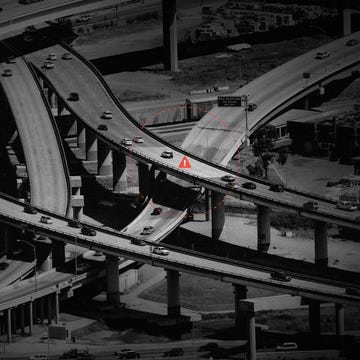The Banqiao Dam was supposed to be a masterpiece of human engineering. An earthen embankment dam straddling China’s Ru River, it was an attempt to harness water to irrigate farmland in the Huai River Basin, an area that covers several provinces and is home to 170 million people. Its core was made up of tons of packed, piled clay, which is largely impervious to water penetration, surrounded by a thick shell of sand. The dam was eight stories tall, tasked with keeping 158 billion gallons of water—the equivalent of 240,000 Olympic-size swimming pools—from pouring into the villages below.
Construction of the dam took 15 months, and when it was finished, in 1952, Banqiao was heralded by government officials as “the iron dam”—tall enough, wide enough, and sturdy enough to withstand 100-year floods and 1,000-year catastrophic floods. It was, you could say, the Titanic of dams. And yet, 23 years after its construction, the structure lay in ruins and 85,000 people were dead in what Human Rights Watch, a nonprofit that investigates human-rights abuses across the world, later called “the largest known dam disaster in human history.”
How did a dam purported to be indestructible become a historical monument to hubris? And why have most people never heard of it? A state coverup long hid the series of errors that doomed the Banqiao Dam, but there are lessons in the story that could save our ailing dams today.
Not long after Mao Zedong’s communist government took power in 1949, a rapid dam-building campaign commenced in China. Chairman Mao was driven, in part, by an urge to modernize the country. Harnessing the waters of China’s rivers for soil irrigation was a key part of this campaign, and in the following decade, more than 100 dams were built just in the country’s central Henan Province, where the Huai River Basin is located. Many people cheered this initiative, but a scientist named Chen Xing looked on in a state of dread.
In the 1950s, Chen was one of China’s foremost hydrologists. An expert in water conservancy, he designed the Suya Lake Reservoir, at the time the largest reservoir project in Asia. As Chen watched the dams pop up, he worried that other important water conservation work was being ignored. A secondary purpose of the dams was to curb flooding, but Chen believed that other efforts—dredging riverbeds, maintaining dikes, and creating flood diversion channels and temporary storage zones—were also vitally important in making sure water wouldn’t wreak havoc in the wake of severe weather events.
In the confined Huai River Basin, where the Banqiao Dam was constructed, these concerns were even more acute. Overbuilding dams and reservoirs in surrounding Henan would raise the water table to unsafe levels, water logging agricultural land. Plains previously used for flood diversion were now the locations of enormous reservoirs. If the Banqiao Dam did collapse, the water would have nowhere to go: People lived on the old flood plains, and any uninhabited soil was saturated.
Chen’s advice was to add 12 gated channels, called sluice gates, to the Banqiao Dam. These would allow excess reservoir water to be discharged down the Ru River in the event of a heavy storm.
His concerns were more than just shrugged off: Chen was maligned by the government as a “right-wing opportunist” and eventually forced from his job overseeing the design of several other dam projects in the region. Only five sluice gates were installed in the dam.
From there, the missteps only intensified. The workers who put up the dam had no experience building reservoirs. Cracks formed in the five sluice gates the government had allowed, as well as in the dam itself. The cracks were eventually fixed with guidance from Soviet engineers, but there was no regular maintenance or inspection to determine if the repaired dam could withstand a cataclysmic rainstorm.
“You have to think about dams as living organisms that need lifetime care,” says engineer Dan Wade, a water resources infrastructure expert at GEI Consultants in California. The Banqiao Dam, by all accounts, barely had any care at all.
And then the weather arrived.
According to the Chinese government, the Banqiao Dam was supposed to withstand a 1,000-year storm. Typhoon Nina, which hit it on August 5, 1975, was a 2,000-year storm. It was so fierce that Eric Fish, reporting for the Economic Observer in 2013, wrote that witnesses saw the ground “littered with birds that had been pummeled to death by the intense rainfall.” As the superstorm rolled across central China from the east, it collided with cold atmospheric air, which effectively held it in place over the Huai River Basin. In three days’ time, it dumped more than 55 inches of rain on a region that typically received less than 32 inches a year. The rainfall was nearly half of the maximum capacity of water that the reservoir behind the Banqiao Dam was originally designed to hold. That amount raised the reservoir’s water level to 370 feet, or about 14 feet higher than what the dam’s wall was supposed to hold back.
At that point the dam was in serious danger. “[Earthen dams] are just as safe as concrete dams if they’re built properly,” says Wade. But an earthen dam has one fundamental weakness, he cautions: “You have to avoid overtopping that dam at all costs.” Water running over an earthen dam washes away the packed material—sand, clay, or soil—at the dam’s summit. Further erosion follows, leading to collapse.
In those critical hours on August 5 when the storm first rolled in, discharging the Ru River’s floodwaters through the sluice gates would have been the correct move. But at first the dam’s operators were told to keep the gates closed. Fish explains that the gates remained unopened in order to mitigate severe flooding downstream that was already underway once the typhoon’s course stalled over Henan Province. By the time the situation grew dire, communication lines had been knocked out by the storm. With no information, Banqiao’s operators waited too long to open the five sluice gates, which, as Chen Xing had predicted, were not enough. Accumulated silt from the reservoir bed also blocked the gates as rain continued to fall.
Shortly after 1 a.m. on August 8, workers filling sandbags on the crest of the Banqiao Dam saw reservoir water spilling over. A few inches of water turned into a few feet, racing over and chewing away at the dam’s crest. The dam was soon pulverized by hundreds of thousands of gallons of water. A wall of water nearly 20 feet high rushed through at 30 miles an hour, cascading into the valleys and plains below. Over the next five hours, the tidal waves that broke through Banqiao toppled another 62 smaller dams in its path, destroying entire towns.
“The blare of the dam burst sounded like the sky was collapsing and the earth was cracking,” recalled one survivor. “Houses and trees disappeared all in an instant.”
About 85,000 people died in the first two hours of the raging floodwaters. More than 100,000 more died from hunger and disease in the weeks that followed , as the waters cut them off from supply lines and medical assistance. According to the account of Chinese journalistYi Si (a pseudonym), more than a million people were “trapped in the water.” On August 21, 13 days following the collapse of the Banqiao Dam, nearly 400,000 people were still stuck on rooftops or on small patches of dry land. Food was air-dropped, but Yi estimated that half of those supplies landed in the water.
“Some two weeks after the disaster, when the flood waters finally began to retreat … mounds of corpses lay everywhere in sight, rotting and decaying under the hot sun,” Yi wrote.
Days after the dam fell, a team of senior government officials took a helicopter ride to survey the damage. With them was Chen Xing, the once-defamed hydrologist who was welcomed back. He was, after all, the one who had warned that the disaster to which they were now bearing witness was waiting to happen.
In some respects, the Banqiao disaster is a cautionary tale for the next few decades, in both the United States and China. Some 100,000 dams currently sit on Chinese rivers, and they continue to be major conduits not only for hydropower generation but also for storing and carefully releasing river waters. A 2012 report from Probe International, an independent environmental advocacy group based in Canada, found that more than 130 of these dams are either vulnerable to earthquakes or could induce them, leading to failure. (Dams in areas of high seismicity can activate faults during procedures such as filling or draining a reservoir.)
In the U.S., thousands of dams are also reaching or overstaying their engineered limits, according to a recent Associated Press analysis. Many require enough maintenance and upgrading that the American Society of Civil Engineers has seen fit to give U.S. water-controlling infrastructure a grade of D. What’s more, that same Associated Press report calculates that 2,200 dams in remarkably poor condition are situated in places where their failure would likely kill people downstream.
Some help is coming. About $3 billion in the infrastructure package signed into law last year is earmarked for America’s dams, but as Mark Ogden, a technical specialist with the Association of State Dam Safety Officials says, more is needed.
“There are more than a couple thousand high-hazard-potential dams in the U.S. that are considered deficient,” he says. “There’s not enough money to be able to adequately inspect and assess all the existing dams out there.”
All the money in the world might not make a difference. As Patrick McCully, a U.S.-based climate and energy analyst, outlines in his book, Silenced Rivers: The Ecology and Politics of Large Dams, constructing a totally safe dam “is simply not possible.” Dams are marvels of defensive engineering, and designers try to think of every imaginable force that might place stress on the structure—but even the biggest dams can come up short.
Why is this the case? The math used to figure out a dam’s impenetrability relies, to an extent, on guesswork, says David Shankman, Ph.D., a professor emeritus of geography at the University of Alabama whose research has focused on the hydrology of rivers, including the Yangtze River near Henan. Most of the time, Shankman says, engineers and hydrologists can find good data on extreme weather events dating back 100 years, which allows them to imagine a dam that can withstand the worst weather event over a 100-year period. They might assume, for example, that the single worst storm of the past 100 years has a one percent chance of happening every year of the next hundred.
This calculation is called the Annual Exceedance Probability and it gives you more protection the farther back in the meteorological record you go. There’s just one problem: You can’t build a dam that could resist anything the earth could throw at it.
“You don’t have 1,000 years of data,” Shankman says. And even if you did, with worldwide weather patterns changing, and once-in-a-lifetime storms such as Sandy and Harvey expected to increase due to climate change. “You’re just predicting the future, and you don’t really know,” Shankman says.
As for Banqiao, the full toll was hidden by the Chinese government until 1995, two decades after the breach, when the first complete accounting of the disaster came out thanks to Human Rights Watch. In the meantime, Chinese officials had announced a reconstruction plan in 1986. The dam would be rebuilt several feet higher than it was before. In 1993, in the face of widespread local opposition, it took its place back across the Ru River.
Andrew Zaleski, a writer based near Washington, D.C., covers science, technology, and business.
